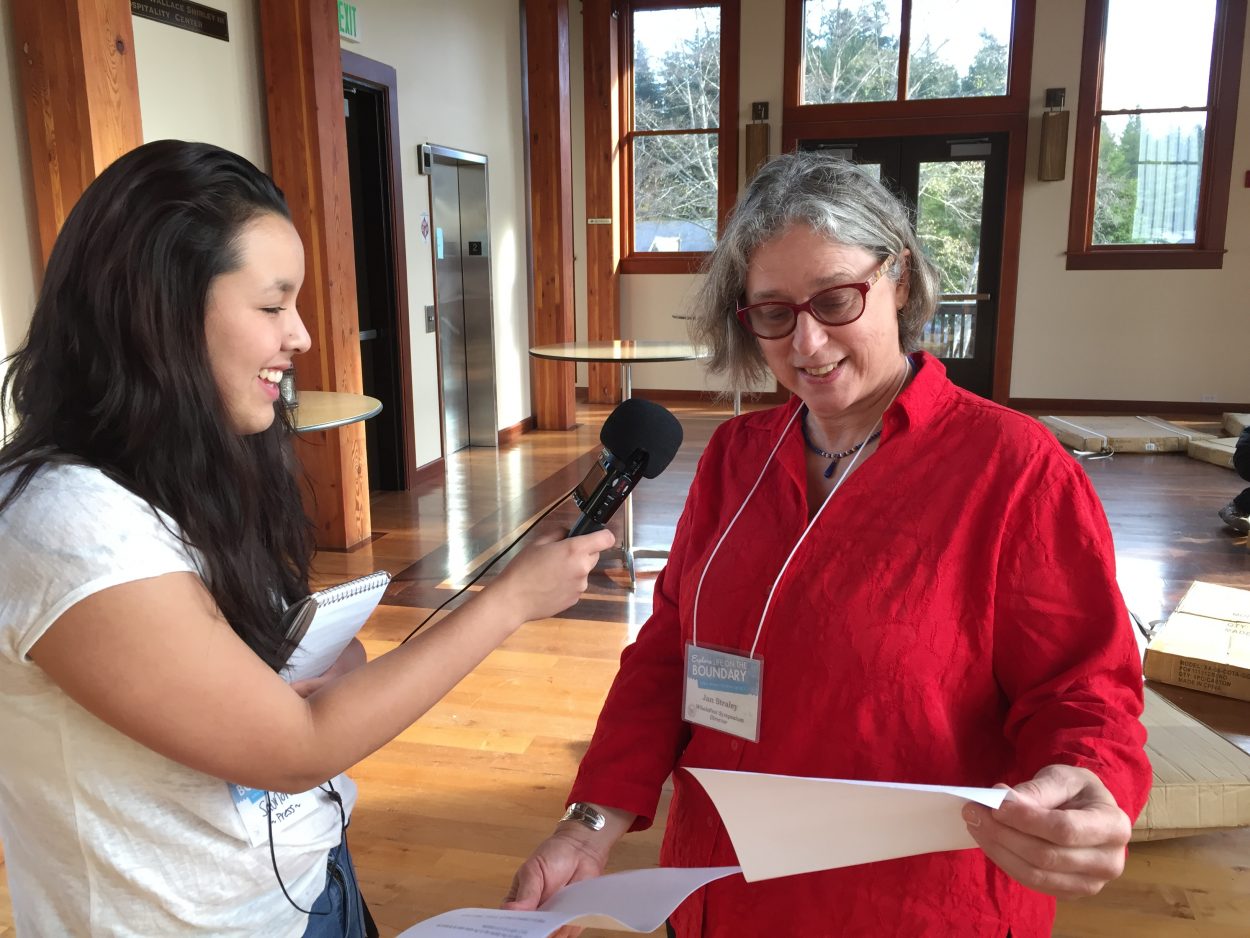
Mt. Edgecumbe senior Saundra Gemmill is interning with the Raven News Department and wanted to learn more about the Whalefest theme. So, she tracked down University of Alaska Southeast whale biologist Jan Straley. (Emily Kwong/KCAW photo)
Shallow Apex. Deep Edge. Frozen Border. These were the central topics at this weekend’s WhaleFest (11-06-15 – 11-08-15). In its 19th year, the annual science symposium is organized by the Sitka Sound Science Center and features three days of lectures, markets, and whale cruises. The theme this year was “Life on the Boundary” – devoted to scientific study at the edges of the ocean.
Mt. Edgecumbe senior Saundra Gemmill is interning with the Raven News Department and wanted to learn more about the Whalefest theme. So, she tracked down University of Alaska Southeast whale biologist Jan Straley.

The three-day symposium was widely attended. Participants listen to a talk by Mette Kaufman at sea life under the ice. (Emily Kwong/KCAW photo)
Straley: What do you call a band of killer whales?
KCAW: What do you call them?
Straley: An orca-stra. (Laughs) Oh here is a good one. How are a dog and a marine biologist alike?
KCAW: How?
Straley: One wags a tail and the other tags a whale.
KCAW: (Laughs) I want to talk to you about the theme, which is…
Straley: Life on the Boundary. We came up with this theme about boundaries because we had had a request for somebody to do a session on estuaries and estuaries are on the boundary of the terrestrial and the marine environment. So we thought, ‘Well, hey!’ So [the Friday seminars were about] (11-06-15), estuaries and the shallow apex – where the intertidal and the terrestrial meets the maine. And then Saturday (11-07-15) was the deep ocean. And today we have the ice edge. So they’re all boundaries of the oceans.

The WhaleFest included a market with maritime-themed vendors and specialty items. (Emily Kwong/KCAW photo)
Saundra also spoke with Dr. Michael Castellini (UAS Fairbanks), Jamal Moss (NOAA Fisheries), Leora Gansworth (Peninsula College), and Sofia Andrew (Mt. Edgecumbe High School student).
Castellini: Dr. Michael Castellini from the University of Alaska Fairbanks. I think one of the most interesting things that we learned was probably last night from our keynote speaker Richard Glen from Barrow. How the peoples of the North Slope have moved all over that area over the last hundreds of years and how everybody is related to each other and how there could be cousins 200 miles apart, but they sort of grew up together. The boundaries…there really are no boundaries. So that’s what we’re talking about this time. That was great.
Moss: Jamal Moss. I’m with NOAA Fisheries and I’m here with my family. We come every year for Sitka WhaleFest. I’m excited about today learning about things that live under the ice. The Arctic is changing so fast. It’s really interesting.
Gansworth: Leora Gansworth. Peninsula College. I’m surprised to see the level of engagement of indigenous peoples and I’m really happy to say that because I come from an indigenous community also. I’m a member of the Anishinaabe nation and our lands and waters are very much of concern to us as well. So seeing the different indigenous scientists and teachers and students has been really inspiring.
Andrew: Sofia Andrew and I’m a student from Mt. Edgecumbe High School. This is my second time attending WhaleFest. Last [year] I came and I’ve just been inspired by marine biology ever since. Throughout the talks and lectures I’ve sat through, I’ve learned a lot of valuable things about our sea and climate change. I feel very fortunate to be here.
WhaleFest is organized by the Sitka Sound Science Center and was held on the Sitka Fine Arts Campus. Among the vendors at the market was the Sitka National Historical Park. (Emily Kwong/KCAW photo)
































